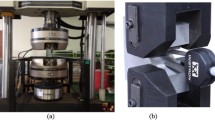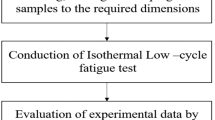Abstract
Nitrogen enhanced 316LN SS is being considered as the candidate structural material for primary side components of sodium cooled fast reactors (SFRs) under future SFR program of India. The structural components of Indian SFR are designed against low cycle fatigue (LCF) as per the French RCC-MR code that provides guidelines for the design and construction of fast reactors. In the present study, LCF design data for nitrogen enhanced 316LN stainless steel (SS) with 0.14 wt.% N are derived from experimental LCF data at temperature 873 K, as per the guidelines of RCC-MR design code. Based on the guidelines, the procedure is outlined for generating design data on cyclic curve, plastic strain concentration factor, Poisson’s ratio correction factor, Neuber’s hyperbola, and strain-life fatigue design curves. Furthermore, the criterion to estimate the allowable design fatigue cycles is also presented. The generated LCF design data on nitrogen enhanced 316LN SS are compared with the codified LCF data on RCC-MR 316LN SS and it must be mentioned that nitrogen enhanced 316LN SS promises better high-temperature resistance to LCF deformation in comparison to the codified 316LN SS (0.06–0.08 wt.% N).




Similar content being viewed by others
References
Bhaduri AK, Laha K, Ganesan V, Sakthivel T, Nandagopal M et al (2016) Advanced materials for structural components of Indian sodium cooled fast reactors. Intl J Press Vess Piping 139–140:123–136
Chellapandi P, Chetal SC, Raj B (2009) Thermal striping limits for components of sodium cooled fast spectrum reactors. Nucl Eng Des 239:2754–2765
Degallaix S, Degallaix G, Foct J (1988) Influence of nitrogen solutes and precipitates on low cycle fatigue of 316L stainless steels, In: Solomon HD, Halford GR, Kaisand LR, Leis BN (eds) Low cycle fatigue. ASTM STP 942: 798–811.
Gavriljuk VG, Berns H (1999) High nitrogen steels: structure, properties, manufacture, applications, 1st edn. Springer Verlag, Berlin
Hubel H (1987) A new concept for plastic strain concentration factors, low cycle fatigue and elasto-plastic behaviour of materials. Elsevier Applied Science, New York, pp 487–492
Kim DW, Ryu WS, Hong JH, Choi SK (1998) Effect of nitrogen on high temperature low cycle fatigue behavior in type 316L stainless steel. J Nucl Mater 254:226–233
Koo G-H, Yoo B (2001) Evaluation of creep–fatigue damage of KALIMER reactor internals using the elastic analysis method in RCC-MR. J Korean Nucl Soc 33:566–584
Mariappan K, Shankar V, Sandhya R, Laha K (2016) Low cycle fatigue design data for India-specific reduced activation ferritic-martensitic (IN-RAFM) steel. Fusion Eng Des 104:76–83
Mathew MD, Laha K, Ganesan V (2012) Improving creep strength of 316L stainless steel by alloying with nitrogen. Mater Sci Eng A 535:76–83
Moulin D, Roche RL (1985) Correction of the Poisson effect in the elastic analysis of low-cycle fatigue. Intl J Press Vess Piping 19:213–233
Nilsson JO (1984) The influence of nitrogen on high temperature low cycle fatigue behavior of austenitic stainless steels. Fatigue Fract Eng Mater Struct 7:55–64
Prasad Reddy GV, Sandhya R, Sankaran S, Mathew MD (2014) Lowcycle fatigue behavior of 316LN stainless steel alloyed with varying nitrogen content: part I: cyclic deformation behaviour. Metall Mater Trans A 45(11):5044–5056
Prasad Reddy GV, Mariappan K, Kannan R, Sandhya R, Sankaran S, Bhanu Sankara Rao K (2015a) Effect of strain rate on low cycle fatigue of 316LN stainless steel with varying nitrogen content: Part-I Cyclic deformation behavior. Intl J Fatigue 81:299–308
Prasad Reddy GV, Mariappan K, Kannan R, Sandhya R, Sankaran S, Bhanu Sankara Rao K (2015b) Effect of strain rate on low cycle fatigue of 316LN stainless steel with varying nitrogen content: Part-II Fatigue life and fracture. Intl J Fatigue 81:309–317
Raj B, Chellapandi P, Vasudeva Rao PR (2015) Sodium fast reactors with closed fuel cycle. CRC Press, Taylor and Francis, pp 223–240
RCC-MRx (2012) Design and construction rules for mechanical components of nuclear installation, Section III—Tome 1—Subsection Z: Appendix A3, AFCEN
Tribout J, Cordier G, Moulin D (1987) A survey of the French creep-fatigue design rules for LMFBR. Nucl Eng Des 98:445–451
Acknowledgements
Authors would like to thank Mr. M. Srinivasa Rao, Indira Gandhi Centre for Atomic Research, Kalpakkam for the coordination in conducting the fatigue tests.
Author information
Authors and Affiliations
Corresponding author
Additional information
Publisher's Note
Springer Nature remains neutral with regard to jurisdictional claims in published maps and institutional affiliations.
Rights and permissions
About this article
Cite this article
Reddy, G.V.P., Ramana, O.V. Generation of Low Cycle Fatigue Design Data for Nitrogen Enhanced 316LN SS as per RCC-MR Code. Trans Indian Natl. Acad. Eng. 7, 475–481 (2022). https://doi.org/10.1007/s41403-021-00312-0
Received:
Accepted:
Published:
Issue Date:
DOI: https://doi.org/10.1007/s41403-021-00312-0




